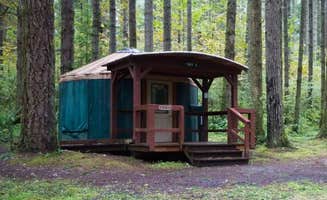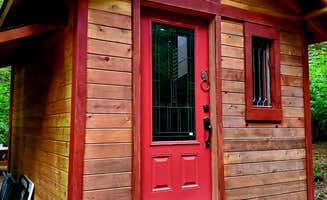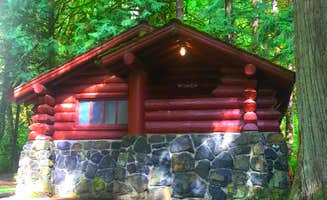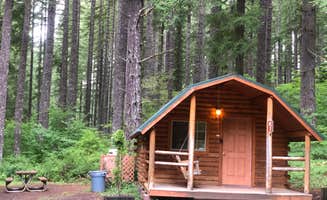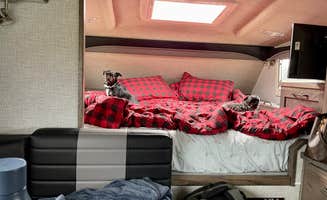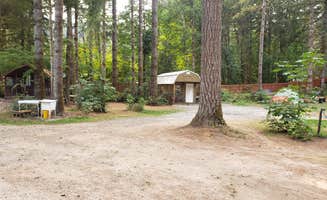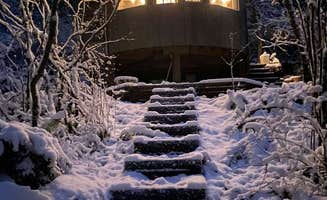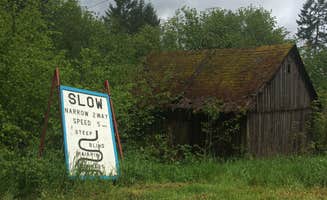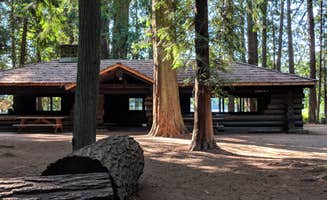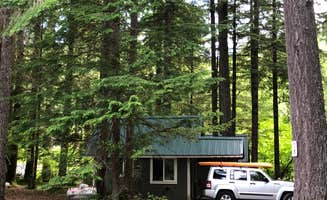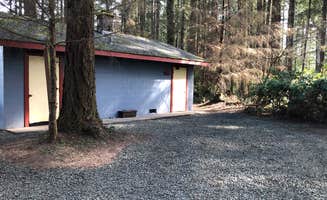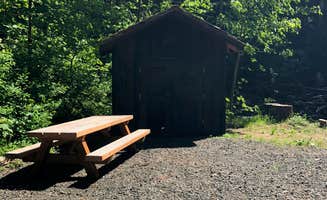The Columbia River region near Castle Rock provides easy access to Mount St. Helens while offering diverse camping experiences at elevations ranging from 50 to 1,000 feet. The area's mild maritime climate supports dense evergreen forests, with summer temperatures typically between 65-85°F. Winter yurt camping remains popular with nighttime temperatures rarely dropping below freezing in the lower elevations.
What to do
Hike to Coldwater Lake: Located about 40 minutes from Lewis & Clark State Park Campground, the lake offers excellent fishing and kayaking opportunities. "We stayed here one night while heading north. Hoped to see Mt. St. Helens but it was overcast. Spoke with a very nice camp host. Clean bathrooms, one women's shower. Walk to Mt. St. Helens visitor center," notes Kim G.
Explore disc golf courses: Several campgrounds feature their own courses, including Paradise Point State Park Campground. "This camp is right off the freeway, but if you're back off the road there's not as much noise, though there's also a train that runs through on the far side. The campground has a small playground and picnic area. Nice place for a quiet, relaxing camping experience," explains Suzanne S.
Watch river traffic: From Skamokawa Vista Park, observe international shipping vessels. "Great views of the Columbia and the Oregon coast. Awesome beach access. Very kid friendly - a nice playground and open play park. Great paddling, cycling and nature trails fairly close-by," shares Jen R.
What campers like
Old growth forest access: The Castle Rock area features remarkable stands of ancient trees. "This campground is split into three loops; an RV loop, Mixed loop, and a predominantly tent loop. The spot itself was very spacious with plenty of room for multiple tents and space to sit around the fire pit. There are several miles if hiking trails which would be rated as easy for most," explains Tom K. about Seaquest State Park Campground.
Quiet yurt camping options: Yurts provide an excellent glamping alternative to traditional tent camping. "Loved the yurt village, which is in its own area on the other side of the campground from the regular sites. Yurts and restrooms were clean. Beware the mosquitos! We always get eaten alive when we stay at Seaquest," warns Rachel.
Waterfront camping: Many campgrounds offer direct water access. "Spectacular Columbia River views from this campground. We camped in the full hookups section in the woods and it was awesome. Next time, we plan to snag a partial hookup spot on the river. Very clean and kid friendly campground!" says Beth C. about Skamokawa Vista Park.
What you should know
Highway noise affects some sites: Several campgrounds sit near major roadways. "There is one down side to the whole experience: Freeway is really really close to the whole camp site. You can hear vehicles at night. If you're a light sleeper or need nature noises when camping - this is not the site for you," advises Susan P. about Paradise Point State Park.
Limited cell service: Many forest sites have poor connectivity. "We stayed here one night while heading north. Very shaded and dense forest. No cell (occasionally 1 bar LTE AT&T). Too heavily forested for Starlink. Had to leave early Monday morning since we were working and needed internet," reports Kim G.
Water access varies: Not all campgrounds have swimming areas. "The day use area is out of the campground and across the main road. There is a playground and beach area. It would have been nice if there was a playground on the campground side of the park," notes Christina F. about Ike Kinswa State Park Campground.
Tips for camping with families
Reserve yurts early: Castle Rock yurt camping options book quickly, especially during summer. "The yurt village was my favorite part about this campground. If you are camping with a large family this would be a perfect spot to try and rent all the spaces. You would essentially have your own bathroom, outdoor play area and there is a camp host dedicated solely to the yurts," recommends Mary C.
Check for junior ranger programs: Several parks offer educational activities. "At night the campground had a great Junior Ranger program with a very enthusiastic park ranger that kept the almost 50 people/kids entertained. She was great at engaging all the kids and teaching them about the park, highly recommend this for anyone bringing kids," shares Ashley B.
Bring mosquito protection: Camp Wilkerson and other forested sites can have persistent insects. "We stayed here as part of a camping trip for my son's cubscout troop. It seemed like a moderately used small campground at the time. My visit was a year ago. They have a large shelter used for weddings. Adirondacks that didn't seem used much, a tent camping area and cabins," explains Ashley Y.
Tips from RVers
Check site dimensions carefully: Not all sites accommodate larger RVs. "We arrived and it was IMPOSSIBLE to get our rig in that site due to the trees. We couldn't even continue out the secondary loop because it was so narrow and had trees on the inside of turns. Not to mention cars sticking out into the roads. The site map is not accurate at all!" warns Alex W. about Paradise Point State Park.
Consider resort-style amenities: Some campgrounds offer additional services. "Lovely RV camp, plenty of trees, full hook-ups, great park to take walks thru, great guests stay here. Good laundry & bathrooms with showers. Even have a good dog washing station," mentions Lorraine S. about Toutle River RV Resort.
Book middle spots to avoid noise: At Toutle River RV Resort, location matters. "It's a nice spot. If you prefer to be closer to the water, Sites 19 and 20 and V1-V13 would be a good choice. 19 and 20 are very nice as they have a concrete pad, and sheltered picnic table. V1-13 have NO privacy between sites; the same is true for 34-43, which are tent-only sites," advises Lee D.


